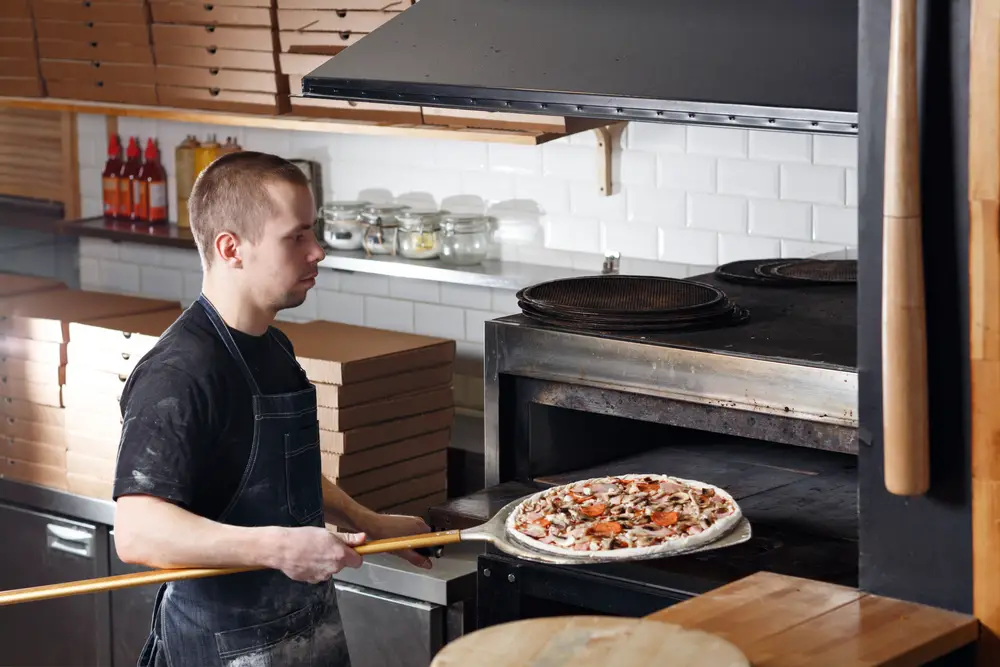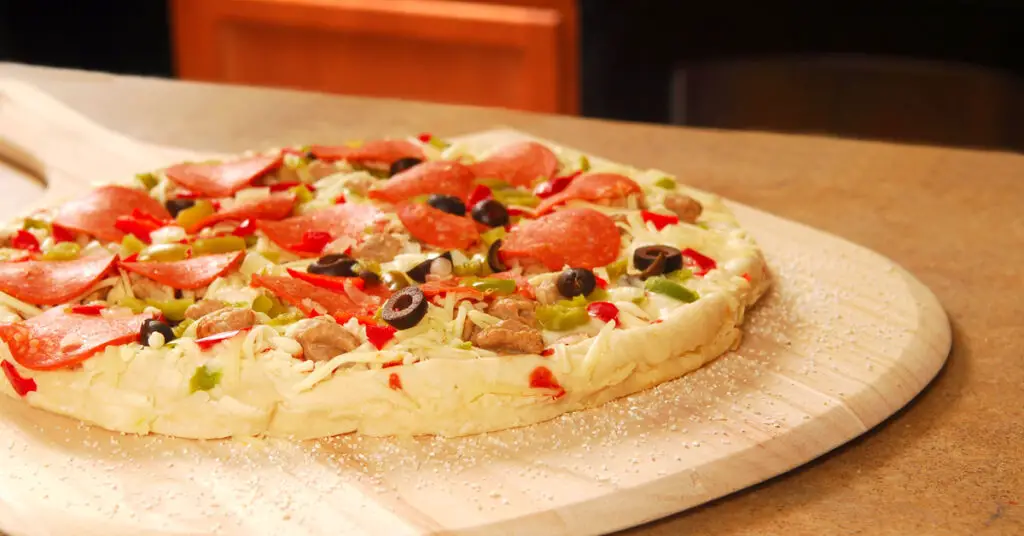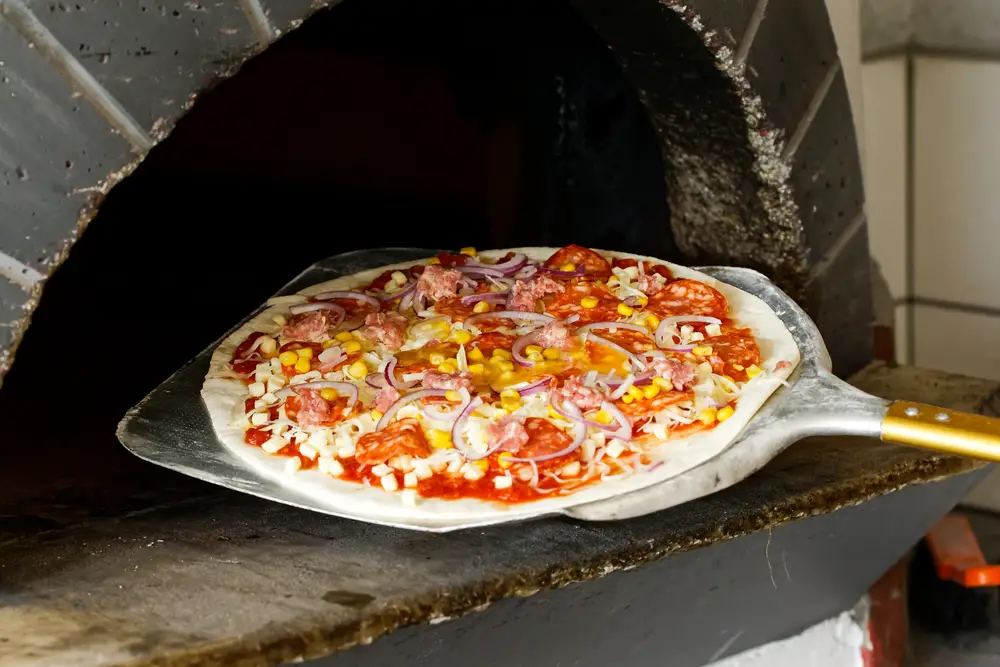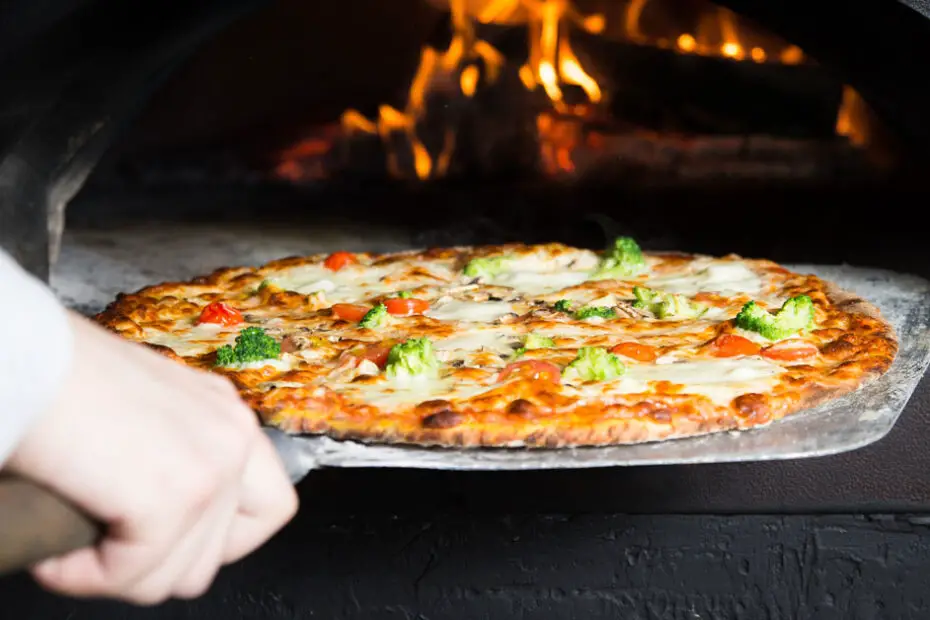Are you a pizza-making pro looking for the ideal tool to complement your skills?
Choosing the right pizza peel is not such a straightforward process! Different materials and styles can make for a tougher-than-expected decision.
Wood and metal are both great options for your pizza peel. However, they each have their benefits and drawbacks as well. In this article, we’ll go over the basics of:
- Which type of pizza peel is easier to clean
- Which type of pizza peel makes for a better pizza
- Which type of pizza peel is more affordable
- Which type of pizza peel is more durable.
Let’s get straight into it!
Metal Vs. Wood Pizza Peel – What’s The Difference?
| Metal Pizza Peel | Wood Pizza Peel | |
| Material | Metal with wooden handle | Wooden surface |
| Heat Conductivity | Conducts heat; wooden handle for safety | Doesn’t conduct heat; safe for hands |
| Advantages | Easy to clean; thin for sliding cooked pizza | Textured surface; traditional aesthetic |
| Sliding Uncooked | Less ideal due to the thin material | Ideal due to textured surface |
| Moisture Management | Prone to trapping moisture between crust and peel surface | Breathable material for traditional airing |
| Durability | Durable, long-lasting | Can warp and split with regular use |
| Handling | Handle with care due to heat conductivity | Safe handling with wooden surface |
| Delicate Pizzas | Suitable for delicate pizzas; thin material | May not be ideal for delicate pizzas |
| Cleaning | Easy to clean with minimal effort | Requires more care during cleaning |
| Compatibility | Fits well in modern kitchens with metal | Traditional appeal, may not fit modern |
Pizza peels that are both wood and metal are commonly found, but don’t get confused by this!
When it comes to wood vs metal peels, it’s the material of the surface on which the pizza sits that we are referring to here.
Even metal pizza peels commonly have a long wooden handle, as wood does not conduct heat and won’t burn your hands.
Both wooden and metal pizza slices have their place in the kitchen. However, depending on your specific needs and pizza-making habits, you may find that a pizza peel made from one of these materials suits your kitchen much better.
Wooden Pizza Peels

Wood is the most traditional material for pizza peels. If the right wood is used, it makes for a textured and nicely weighted peel that will allow certain advantages during the pizza-making process.
Wood also has an aesthetic appeal which is an important consideration for many chefs. However, in a modern kitchen that contains a collection of metallic appliances, a metal pizza peel may just fit right in!
Wooden pizza peels are generally considered to be the best option for sliding uncooked pizzas into the pizza oven due to their texture.
The texture of a good quality wooden peel reduces the risk of dough sticking to the peel and causing damage to the uncooked pizza.
A wooden texture also prevents potential slippage. This is because the dough attaches itself to the textured surface enough so that it will not slide too freely, but will slide into the oven when the correct motion is actioned.
Wood is a breathable material, which allows for pizza to air in the traditional manner.
When resting on alternative types of pizza peel, moisture can get trapped between the underside of the crust and the peel. This can lead to the pizza crust losing its structural integrity and suffering damage.
This point is particularly relevant if you are using a thin marinara sauce, as you might for pizza such as pepperoni or Margherita pizza. This runny sauce can moisten the dough from the top down and inevitably lead to sticking.
Metal Pizza Peels
Metal pizza peels certainly have their place in the pizza-making artillery too. In fact, they are preferable to wooden peels in many ways!
If a quick clean-up is imperative to your pizza night, then metal may just be the perfect material for your pizza peel.
Metal pizza peels can be cleaned with the greatest of ease, using minimal scrubbing, soaking, chemicals, or abrasive techniques.
It is also the most ideal tool for sliding underneath your cooked pizza due to how thin of a material it is. With a metal pizza peel, you can turn and retrieve your pizza from the oven with ease.
Wooden pizza peels tend to be thicker in width, meaning they are not ideal tools for sliding underneath pizzas.
This is especially true for those more delicate pizzas containing a lot of toppings, such as veggie supreme or capriccioso.
The crust of these types of pizzas is under more weight pressure and tends to hold more moisture, so are also the easiest to damage.
Another great thing about metal is its durability. Once you’ve bought your metal pizza peel, it’ll be with you for life! Wooden pizza peels, on the other hand, can warp and split after just a short time of regular use.
However, in saying this, a wooden-handled metal pizza peel is preferable to one with an entirely metal composition. These should be avoided as the risk of burning your hands on hot metal is significant.
What Is Better: A Wood or Metal Pizza Peel?

Wood and metal pizza peels both have their benefits. You may find that either a wood or metal pizza peel suits your specific needs more ideally.
However, for the reasons detailed below, I have found that metal pizza peels generally serve a wider set of needs than wood does:
Softer Dough: Use Wooden Peel
Soft dough makes for the most wonderfully light and moreish pizza crust. The only issue with a soft dough is that it can often be damaged during its transfer from peel to oven!
This occurs more often when using a metal peel because of the material’s textureless finish.
Wood, however, has a perfectly porous natural texture which prevents sticking and thus reduces the risk of damage.
The porous texture of wood allows for excess moisture to escape through the wood rather than gathering under the dough and melding it to the peel.
Be sure that your wooden pizza peel has a beveled edge. This is a gentle slope leading to a sharp edge that can effectively slide underneath the pizza. Wooden pizza peels without beveled edges can be difficult to use due to their thickness.
If you are using soft dough on a metal pizza peel, there are ways to avoid dough sticking. Simply coat the pizza peel in flour or cornmeal, and this will absorb any excess moisture and work to create a crispier base.
If you’re using flour to prevent sticking, be sure to not use too much. Excessive flour exposed to the heat of the oven can burn and infuse the pizza with a nasty burnt taste.
Cornmeal, on the other hand, is a flavorful and textured ingredient that adds another element to your pizza.
Affordability: Choose Metallic Pizza Peel
Metallic pizza peels are considerably cheaper to buy online or in-store. Not only that, but they’re also more durable – meaning that a metal pizza peel will last a whole lot longer than a wooden pizza peel of the same price.
Wooden pizza peels can have a similar level of durability, but this comes at a much higher price point to account for quality wood such as maple or walnut.
With wooden pizza peels that compare price-wise to metal peels, you should expect a wood of a much poorer quality.
Such lower-quality wooden pizza peels warp with moisture and extended heat exposure, and they can also split and chip quite easily. Due to these reasons, wooden pizza peels tend to age quickly.
So, if you care about appearances, you’ll need to replace these more frequently. However, there are measures to slow down the aging process, such as using mineral oils as a protective varnish.
You should be sure to varnish your wooden pizza peel no matter its level of quality. Not only does this work to protect the peel from damage caused by heat and moisture, but it also protects the wood from nasty sauce and grease stains.
These stains can be seriously frustrating, as no matter how hard you scrub with harsh chemicals – they’re here to stay!
Taking this step will add years to the life of the wood and save you money in the long run. Just be sure that the mineral oil you are using is safe for trace consumption and will hold up under heat exposure.
Cleaning: Pick Metallic Pizza Peel

Wooden pizza peels are more difficult to clean than metal pizza peels. They’re easy to stain with sauce and oil and also are easier to damage with chips and scratches that commonly occur during cleaning.
Grease and mess glide off the metal surfaces without the need for soaking overnight or intensive scrubbing.
Steel is also a durable material that will not get damaged easily with exposure to heat, moisture, or abrasion. This means that your pizza peel will stay looking newer for longer, as well as maintaining its function.
Aluminum is an excellent metal for pizza peels as there is no risk of it becoming rusty due to abrasion and moisture exposure. With other metals, this is a risk that must be considered.
Grip: Pick Bamboo Pizza Peel
Bamboo is an excellent material for pizza peels. It has a perfectly smooth texture which makes it easy for pizza to slide on and off of the peel both before and after cooking. It also allows for maximum air circulation through its porous composition.
It is a good material for crafting a super thin pizza peel as it is strong and highly durable, though not as durable as metal. Bamboo can get charred and otherwise damaged by heat.
Bamboo peels are attractive kitchen utensils that can double as chopping boards or charcuterie platters. Due to their durability, they can withstand a fair amount of cutting on their surface.
Bamboo pizza peels also require minimal care. This is due to their smooth texture that doesn’t trap grease or moisture, as well as their strength and durability.
FAQs
Why use a wooden pizza peel?
Not only are wooden pizza peels attractive additions to your kitchen, but they’re practical too.
The porous nature of wood allows for pizza to effectively aerate so as to not trap moisture between the pizza peel and dough or crust.
What is the best coating for pizza peel?
Mineral oils are the best products to use as a coating or finish on your wood pizza peel.
This will help to prevent damage to your pizza peel by way of heat or abrasion. Mineral oils are clear, colorless, and odorless oils, unlike edible vegetable oils.
What is best to use on a pizza peel to prevent sticking?
Flour is the perfect ingredient to use on your pizza peel to prevent pizza dough from sticking to the peel. If it does stick, this can lead to your pizza tearing as you attempt to remove it from the peel.
Another ingredient that you can use is cornmeal. This works like flour to prevent sticking but also adds a lovely taste and crispiness to your base.
As someone from Long Island, New York, Thomas knows what it takes to make a good pizza. He understands that it’s a combination of high-quality ingredients, well-rounded pizza ovens, and a little bit of love. From the dough of a Neapolitan-style pizza to the wood that powers a wood-fired pizza oven, he has you covered. Thomas’ love of pizza is what got him here and he hopes that you’ll enjoy pizza as much as he does soon.
